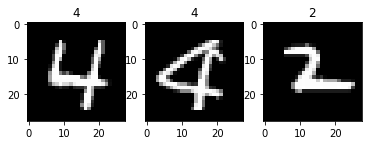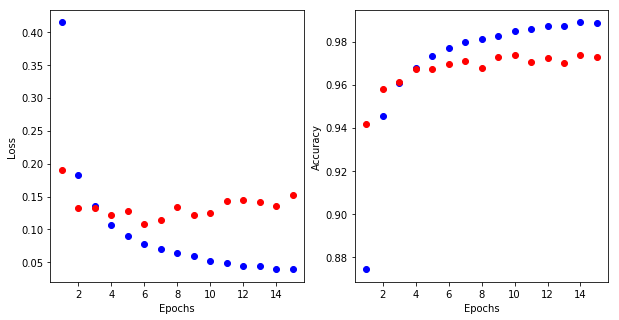Basic Neural Network for MNIST with Keras
Mar 29, 2017 15:26 · 741 words · 4 minutes read
This is a simple tutorial on a basic 97% accurate neural network model for MNIST digit classification. This model contains multiple RELU layers and dropouts layers with a softmax layer for prediction.
Only less than 30 seconds of training time is required on my 15 inch Macbook. I strongly recommend using jupyter notebook, but normal python terminal is fine too.
# install some libraries if don't have them
pip3 install numpy pandas scipy sklearn tensorflow keras matplotlib
Setting up python environment
import numpy as np
import pandas as pd
import matplotlib.pyplot as plt
Loading data sets
# List our data sets
from subprocess import check_output
print(check_output(["ls", "data"]).decode("utf8"))
# Loading data with Pandas
train = pd.read_csv('data/train.csv')
train_images = train.ix[:,1:].values.astype('float32')
train_labels = train.ix[:,0].values.astype('int32')
test_images = pd.read_csv('data/test.csv').values.astype('float32')
print(train_images.shape, train_labels.shape, test_images.shape)
output:
sample_submission.csv
test.csv
train.csv
(42000, 784) (42000,) (28000, 784)
# Show samples from training data
show_images = train_images.reshape(train_images.shape[0], 28, 28)
n = 3
row = 3
begin = 42
for i in range(begin,begin+n):
plt.subplot(n//row, row, i%row+1)
plt.imshow(show_images[i], cmap=plt.get_cmap('gray'))
plt.title(train_labels[i])

Process data for training
# Normalize pixel values from [0, 255] to [0, 1]
train_images = train_images / 255
test_images = test_images / 255
# Convert labels from [0, 9] to one-hot representation.
from keras.utils.np_utils import to_categorical
train_labels = to_categorical(train_labels)
print(train_labels[0])
print(train_images.shape, train_labels.shape)
output:
[ 0. 1. 0. 0. 0. 0. 0. 0. 0. 0.]
(42000, 784) (42000, 10)
Training neural network
# Create a basic neural network
# 64 relu -> 128 relu -> dropout 0.15
# -> 64 relu -> dropout 0.15 -> softmax 10
from keras.models import Sequential
from keras.layers import Dense , Dropout
model=Sequential()
model.add(Dense(64,activation='relu',input_dim=(28 * 28)))
model.add(Dense(128,activation='relu'))
model.add(Dropout(0.15))
model.add(Dense(64, activation='relu'))
model.add(Dropout(0.15))
model.add(Dense(10,activation='softmax'))
from keras.optimizers import RMSprop
model.compile(optimizer=RMSprop(lr=0.001),
loss='categorical_crossentropy',
metrics=['accuracy'])
# Train our model with 15 steps using 90% for training and 10% for cross validation
history=model.fit(train_images, train_labels, validation_split = 0.1,
epochs=15, batch_size=64)
output:
Train on 37800 samples, validate on 4200 samples
Epoch 1/15
37800/37800 [==============================] - 2s - loss: 0.4146 - acc: 0.8743 - val_loss: 0.1901 - val_acc: 0.9419
Epoch 2/15
37800/37800 [==============================] - 2s - loss: 0.1828 - acc: 0.9454 - val_loss: 0.1334 - val_acc: 0.9581
Epoch 3/15
37800/37800 [==============================] - 2s - loss: 0.1359 - acc: 0.9608 - val_loss: 0.1330 - val_acc: 0.9614
Epoch 4/15
37800/37800 [==============================] - 2s - loss: 0.1071 - acc: 0.9680 - val_loss: 0.1217 - val_acc: 0.9671
Epoch 5/15
37800/37800 [==============================] - 2s - loss: 0.0907 - acc: 0.9731 - val_loss: 0.1281 - val_acc: 0.9674
Epoch 6/15
37800/37800 [==============================] - 2s - loss: 0.0774 - acc: 0.9770 - val_loss: 0.1091 - val_acc: 0.9695
Epoch 7/15
37800/37800 [==============================] - 2s - loss: 0.0701 - acc: 0.9799 - val_loss: 0.1146 - val_acc: 0.9712
Epoch 8/15
37800/37800 [==============================] - 3s - loss: 0.0637 - acc: 0.9813 - val_loss: 0.1338 - val_acc: 0.9679
Epoch 9/15
37800/37800 [==============================] - 2s - loss: 0.0594 - acc: 0.9825 - val_loss: 0.1217 - val_acc: 0.9726
Epoch 10/15
37800/37800 [==============================] - 2s - loss: 0.0519 - acc: 0.9851 - val_loss: 0.1245 - val_acc: 0.9736
Epoch 11/15
37800/37800 [==============================] - 2s - loss: 0.0484 - acc: 0.9858 - val_loss: 0.1435 - val_acc: 0.9705
Epoch 12/15
37800/37800 [==============================] - 2s - loss: 0.0451 - acc: 0.9870 - val_loss: 0.1442 - val_acc: 0.9724
Epoch 13/15
37800/37800 [==============================] - 2s - loss: 0.0442 - acc: 0.9872 - val_loss: 0.1412 - val_acc: 0.9702
Epoch 14/15
37800/37800 [==============================] - 2s - loss: 0.0393 - acc: 0.9889 - val_loss: 0.1361 - val_acc: 0.9738
Epoch 15/15
37800/37800 [==============================] - 2s - loss: 0.0398 - acc: 0.9887 - val_loss: 0.1522 - val_acc: 0.9726
From this output we can see our model is 98.87% accurate on training set and 97.26% accurate on cross validation set.
# Graphing Loss on the left and Accuracy on the right
history_dict = history.history
epochs = range(1, 16)
plt.rcParams["figure.figsize"] = [10,5]
plt.subplot(121)
loss_values = history_dict['loss']
val_loss_values = history_dict['val_loss']
plt.plot(epochs, loss_values, 'bo')
plt.plot(epochs, val_loss_values, 'ro')
plt.xlabel('Epochs')
plt.ylabel('Loss')
plt.subplot(122)
acc_values = history_dict['acc']
val_acc_values = history_dict['val_acc']
plt.plot(epochs, acc_values, 'bo')
plt.plot(epochs, val_acc_values, 'ro')
plt.xlabel('Epochs')
plt.ylabel('Accuracy')
plt.show()

Make prediction
# Generate prediction for test set
predictions = model.predict_classes(test_images, verbose=0)
submissions=pd.DataFrame({"ImageId": list(range(1,len(predictions)+1)),
"Label": predictions})
submissions.to_csv("predictions.csv", index=False, header=True)
Everything all together takes about 5 minutes, pretty good for 97% accuracy. There are many ways to improve the accuracy, I might write about them in future. The goal here is just to have a basic working setup and test submissions on Kaggle.

With this simple model we achieved 97.257% accuracy on test set.
Thanks Poonam Ligade for posting her Kaggle Kernel
Try this problem on Kaggle